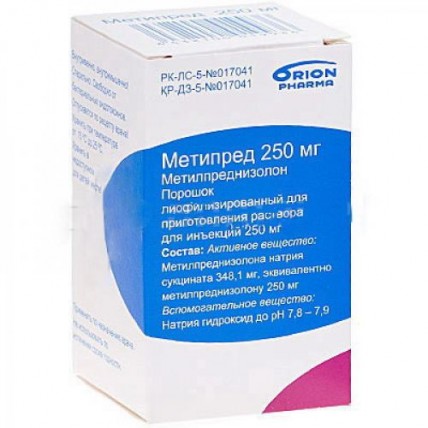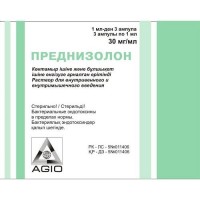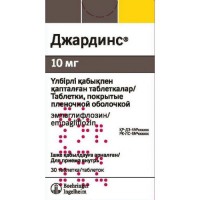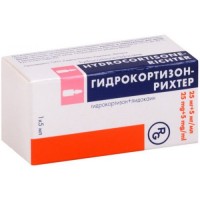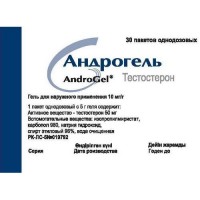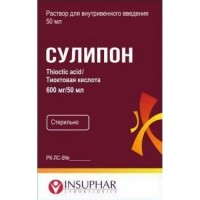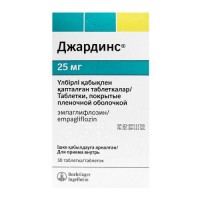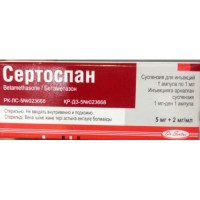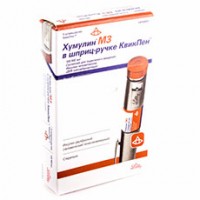Metipred 250 mg / 4 ml 1's powder for injection (vial)
- $21.90
Out Of Stock
The trade name
Methypredum
the International unlicensed
name Methylprednisolonum Dosage Form Powder
the Structure lyophilized for preparation of solution for injections, 250 mg
active agent - sodium Methylprednisolonum succinate, is equivalent to 250 mg of Methylprednisolonum,
excipient - sodium hydroxide of 5 M solution.
Solvent - water for injections.
The description
the Lyophilized powder of white or almost white color. It is hygroscopic.
Pharmacotherapeutic group
Corticosteroids for system use. Glucocorticosteroids.
The code of automatic telephone exchange H02AB04
the Pharmacological
Pharmacokinetics At properties intramuscular administration of Methylprednisolonum the peak of concentration in blood serum is observed in 2 hours, average elimination half-life 23 hours. For 77% Methylprednisolonum contacts plasma proteins, communication with transcortinum is insignificant. The volume of distribution is 11.5 l/kg. Methylprednisolonum is metabolized to inactive metabolites. The specific CYP enzymes providing its transformation are not known. The average clearance is 6.5 ml/kg/min. Duration of anti-inflammatory effect is 1836 hours. About 5% of drug are removed from an organism with urine.
The pharmacodynamics
Effect of Methypredum, as well as other glucocorticoids, is implemented through interaction with steroid receptors in cytoplasm. Steroidretseptorny the complex is transported in a cell kernel, connects to DNA and changes a transcription of genes for the majority of proteins. Glucocorticoids oppress synthesis of numerous proteins, various enzymes causing destruction of joints (in a pseudorheumatism) and also the cytokines playing an important role in immune and inflammatory responses. Induce synthesis of a lipokortin of key protein of neuroendocrinal interaction of glucocorticoids that leads to reduction of the inflammatory and immune response.
Glucocorticoids, including Methypredum, suppress or interfere with development of the fabric answer to many thermal, mechanical, chemical, infectious and immunological agents. Thus, glucocorticoids work symptomatic, reducing manifestations of a disease without impact on the reason. The anti-inflammatory effect of drug at least exceeds efficiency of a hydrocortisone five times.
Endocrine effects of Methypredum include suppression of secretion of AKTG, inhibition of products of endogenous cortisol, at prolonged use cause a partial atrophy of bark of adrenal glands. Influences metabolism of calcium, vitamin D, carbohydrate, protein and lipidic metabolism therefore at prolonged use the increase in content of glucose in blood, reduction of density of a bone tissue, the phenomenon of a muscular atrophy and dislipidemiya can be observed. Drug also promote increase in arterial blood pressure and modulation of behavior and mood. Methypredum has practically no mineralokortikoidny activity.
Indications
- bronchial asthma of a heavy course
- heavy allergic reactions, including an acute anaphylaxis
- ulcer colitis, Crohn's disease
- the system lupus erythematosus, a pseudorheumatism, a spondylarthritis, dermatopolimiozit, Shegren's disease
- for suppression of reaction of graft rejection
- for reduction of intracranial pressure, including in hypostasis of the brain caused by a tumor
- exacerbation of multiple sclerosis, a myasthenia gravis
- hepatitis
- a glomerulonephritis
- eczema, neurodermatitis
- leukemia, a lymphoma, a malignant myeloma in a combination with cytostatics
- as antiemetic against the background of cytostatic therapy
the Route of administration and doses
the Route of administration - slow intravenous, intramuscular injections or intravenous infusions in a dose of 100-500 mg. The dose and duration of treatment is established individually and depends on a disease and degree of its weight.
For solution preparation Methypredum of 250 mg with the lyophilized powder should be added 4 ml of water for injections to a bottle. The received solution has to be transparent, without visible impurity. For intravenous infusion it is necessary to add to the prepared solution 1001000 ml of 5% of solution of a dextrose, normal saline solution or their mix.
The adult at shock and after organ transplantation the intravenous doses reach 30 mg/kg of body weight. High doses (more than 1 mg/kg) should be entered intravenously slowly within 3060 min.
As antiemetic at chemotherapy apply 250 mg of Methypredum in 20 min. prior to reception a cytostatics, continuing therapy if necessary each 6 hours.
For children lower doses are recommended, but they have to make at the same time not less than 25 mg/days.
Elderly patients: there is no need for dose adjustment. The advantage of treatment has to exceed possible risk of emergence of side effects. It is necessary to use drug under observation of the doctor.
Side effects
Development of heavy side reactions depends on the size of a dose and duration of treatment. Side reactions usually develop at long-term treatment by drug, at a short course of treatment the risk of their emergence is improbable.
- development or exacerbation of bacterial, viral and fungal infections, a tuberculosis recurrence, immunosuppression
- increase in total number of leukocytes at decrease in quantity of eosinophils, monocytes and lymphocytes, a thrombocytosis
- hypercoagulation, thrombosis
- oppression gipotalamo - a hypophysial and adrenal system, insufficiency of adrenal glands which leads to arterial hypotension, a hypoglycemia and lethal cases in stressful situations, such as surgical interventions, an injury or an infection if the dose of Methypredum is not increased, delay of growth and a delay of sexual development at children, disturbances of a menstrual cycle, a hirsutism, Cushing's syndrome
- increase in appetite, increase in body weight, decrease in tolerance to carbohydrates increase in need for insulin and oral glucose-lowering drugs, a lipidemia, negative nitrogenous balance, a hypocalcemia, a hypopotassemia, a gipokaliyemichesky alkalosis, a delay of sodium and liquid in an organism
- a headache, dizziness, irritability, uneasiness, labile mood, insomnia, euphoria, a depression, tendency to a suicide, a mania, hallucinations, psychoses, exacerbation of schizophrenia, dementia, convulsive attacks, cognitive dysfunction (including amnesia and confusion of consciousness)
- increase in intraocular pressure, glaucoma, a papilledema, a cataract, thinning of a cornea and sclera, viral and fungus infectious diseases of eyes, an exophthalmos
- a myocardial infarction, heart failure, arterial hypo - or hypertensia, bradycardia, ventricular arrhythmia, an asystolia (as a result of fast administration of drug), atherosclerosis
- allergic reactions, including an acute anaphylaxis with a lethal outcome
- nausea, vomiting, a hiccups, a meteorism, unpleasant taste in a mouth, an esophagitis, ulcers of a gullet, a stomach and a duodenum, perforation and bleedings of a GIT, pancreatitis
- increase in activity of ALT, nuclear heating plant and alkaline phosphatase
- regeneration delay, an atrophy of skin, petechias, hematomas, striya, a teleangiectasia, acne rash, an ecchymoma, a purpura, hyper - or hypopigmentation, Was reported about exceptional cases of the panniculitis which is characterized by emergence of an eritematoz, hot hypodermic thickenings within 2 weeks after drug withdrawal
- osteoporosis, fractures of backbone and long bones, an aseptic osteonecrosis, a rupture of sinews, muscle weakness, an atrophy of muscles, a myopathy
- increase in risk of emergence of urolites, a leukocyturia, an erythrocyturia without the available injury of kidneys, a nocturia
- an indisposition, a resistant hiccups at use of drug in high doses
- at sharp drug withdrawal the withdrawal is possible. Weight of symptoms depends on degree of an atrophy of adrenal glands, a headache, dizziness, anorexia, nausea, an abdominal cavity pain, weakness, changes of mood, a lethargy, heat, myalgia, an arthralgia, rhinitis, conjunctivitis, a painful itching of skin, loss of weight. In more hard cases heavy mental disturbances and increase in intracranial pressure, a steroid pseudorheumatism at patients with rheumatism, death.
- reactions in the injection site: burning and pain, a depigmentation, a leukoderma, a skin atrophy, sterile abscesses, seldom
the Contraindication lipoatrophia
- hypersensitivity to drug components
- tuberculosis and other acute or persistent bacterial or viral infections (without due chemotherapeutic protection)
- system fungal infections
Medicinal interactions
Anticoagulants: at combined use with glucocorticoids strengthening of effect of anticoagulants can be noted. Parenteral administration of Methypredum exponentiates thrombolytic action of antagonists of vitamin K (fluindion, atsenokumarol).
Salicylates and other non-steroidal anti-inflammatory drugs: co-administration of salicylates, indometacin and other non-steroidal anti-inflammatory drugs can increase the probability of an ulceration of a mucous membrane of a stomach. Methypredum can promote reduction of level of salicylates in blood serum, increasing their renal clearance. The care at reduction of a dose of Methypredum at prolonged simultaneous use is necessary.
Hypoglycemic drugs: Methypredum can partially suppress hypoglycemic effect of oral antidiabetic means and insulin.
Inductors of microsomal enzymes of a liver: for example, barbiturates, Phenytoinum, Primidonum, carbamazepine and rifampicin increase system clearance of Methylprednisolonum, thereby reduce effects of Methypredum almost twice.
CYP3A4 inhibitors: for example, erythromycin, klaritromitsin, ketokonazol, diltiazem, an aprepitant, itrakonazol and troleandomitsin reduce elimination and increase Methylprednisolonum level in blood plasma that can lead to strengthening of therapeutic and side effects of Methypredum.
Estrogen: can enhance effects of Methypredum, slowing down his metabolism. It is not recommended to regulate Methypredum doses to the women accepting oral contraceptives which can promote not only increase in elimination half-life, but also development of atypical immunosuppressive effects of Methypredum.
Ftorkhinolona: simultaneous use can lead to injury of sinews.
Amphotericinum, diuretics and light depletive: Methypredum can increase removal of potassium from an organism at the patients receiving at the same time these drugs.
Immunodepressants: Methypredum possesses additive immunosuppressive action that can increase therapeutic effects or risk of development of various side reactions at reception together with other immunodepressants. Only some of these effects can be explained with pharmacokinetic interactions.
Corticosteroids, including Methypredum can increase concentration of a takrolimus in plasma at their combined use, at cancellation of corticosteroids the concentration of a takrolimus in plasma increases.
Improves antiemetic activity of other antiemetic drugs used in parallel at therapy by the antineoplastic drugs causing vomiting.
Immunization: can reduce the immunizing efficiency of vaccines and increase risk of neurologic complications. Use of therapeutic (immunosuppressive) doses together with live virus vaccines can increase risk of developing viral diseases.
Antikholinesterazny means: use of drug and antikholinesterazny means can cause muscle weakness in patients with a myasthenia.
Others: it was reported about two serious cases of a sharp myopathy at the elderly patients receiving a docsakarium chloride and Methylprednisolonum in high doses. At long therapy the glucocorticoids can reduce effect of Somatotropinum.
Cases of emergence of a sharp myopathy at use of corticosteroids for patients who at the same time receive treatment by neuromuscular transmission blockers are described (for example, pankuronium).
At simultaneous use of Methypredum and cyclosporine, cases of developing of spasms were noted. As simultaneous administration of these drugs causes mutual slowing down of metabolism, possibly spasms and other side effects are connected with use of each of these drugs as monotherapy, at their combined use can arise more often.
Special instructions
Owing to weak mineralokortikoidny effect Methypredum cannot be used for replacement therapy in Addison's disease.
Drug has to be used with care and under medical control at patients with arterial hypertension, stagnant heart failure, mental disorders, patients with diabetes (or diabetes in the family anamnesis), pancreatitis, digestive tract diseases (a round ulcer, a local ileitis, ulcer colitis or other inflammatory diseases of an intestinal path or diverticulites with the increased risk of bleeding and perforation), the patient with osteoporosis, a myasthenia, herpes of eyes, a hypothyroidism, a corticosteroid - the induced myopathy in the anamnesis, a liver and renal failure, cirrhosis, epilepsy, abscess or other piogenic infections, glaucoma, to patients with tendency to thrombophlebitis, the patients who recently had a myocardial infarction.
Glucocorticoids can complicate diagnostics of complications of diseases of digestive tract as they cause reduction of a pain syndrome and also to mask hyper parathyroidism stage of latency.
Methypredum can potentiate ulcerogenic action of salicylates and other non-steroidal anti-inflammatory drugs.
Patients with disturbance of blood clotting have to be under medical control. At combined use of Methypredum and anticoagulants the risk of a gastric ulceration and bleeding increases. The mode of dosing of anticoagulants has to be followed surely by control of a prothrombin time, namely: international normalized index (INI).
Methypredum, as well as other glucocorticoids, can promote exacerbation of infectious diseases. There is a risk of a recurrence of tuberculosis and complications of chicken pox and the surrounding herpes.
It is not necessary to apply live vaccines to patients who accept corticosteroids for system use in high doses during the immunosuppression induction period. Therapeutic reaction to other types of vaccines can be also weakened. With care to apply within 8 weeks before vaccination, in lymphadenitis after BCZh inoculation, in immunodeficiency, including in AIDS or HIV infection.
At long therapy by Methypredum it is necessary to consider a question of prescribing of biphosphonates sick osteoporosis or with risk factors of its development. Risk factors of osteoporosis are age 65 years, frequent changes in the anamnesis or in the family anamnesis, an early menopause (up to 45 years), a premenopauzalny amenorrhea and small body weight are more senior. Risk of developing osteoporosis can be minimized by regulation of a dose of Methypredum, reducing it to the lowest therapeutic level.
Long reception of glucocorticoids suppresses a hypophysial and adrenal system that leads to development of secondary insufficiency of the kortikoadrenalovy answer that can lead to exacerbation of diseases and development of complications under various conditions, for example in acute injuries, diseases or surgical intervention. High doses of Methypredum considerably reduce risk of development of the listed complications.
For minimization of side effects the full daily dose of Methypredum needs to be accepted in the morning according to a circadian rhythm of endogenous development of cortisol.
Patients with a hypothyroidism or a serious illness of a liver should reduce Methypredum dose.
To elderly patients drug has to be appointed with care because of the increased risk of development of side effects (round ulcer, osteoporosis and an ulceration of skin).
At prolonged use of glucocorticoids the therapy should be stopped gradually, for several weeks, in order to avoid a withdrawal and serious complications, including lethality. Long-term therapy should not stop suddenly and in case of pregnancy.
Pregnancy and the period of a lactation
Drug gets through a placenta and is allocated in milk during feeding with a breast.
It is necessary to weigh carefully advantage and risk of intake of Methypredum during pregnancy. Glucocorticoids can also increase risk of stillbirth rate. Newborns from mothers accepting glucocorticoids during pregnancy have to be exposed to careful inspection on presence of signs of a hypnoadrenalism and also according to indications it is necessary to appoint replacement therapy.
It is necessary to avoid feeding by a breast at long system therapy by Methypredum.
A dose and duration of therapy the doctor defines use in pediatrics At use for children individually, depending on age and weight of course of a disease.
At long reception at children the delay of growth and a delay of sexual development is possible.
Features of influence of medicine on ability to run motor transport and potentially dangerous mechanisms
Considering side effects of drug (risk of emergence of disturbances of mood, mentality, a spasm, a headache) at use of drug it is necessary to refrain from control of motor transport or other potentially dangerous mechanisms.
Overdose
Symptoms: now about cases of overdose of the drug Methypredum it was not reported, strengthening of side effects of drug is possible.
Treatment: in case of overdose it is necessary to carry out symptomatic treatment. Specific antidote does not exist.
The form of release and packing
On 348.1 mg of drug place in the bottles from transparent glass corked by rubber bungs and which are pressed out by aluminum caps.
On 1 bottle with drug and together with the instruction for medical use in the state and Russian languages place in a pack from cardboard.
To Store storage conditions at the room temperature of 1525 of C.
To store out of children's reach!
Not to apply a period of storage of 5 years after the expiry date specified on packing
Prescription status
According to the prescription
Corporation Orion Producer
To develop
Methypredum
the International unlicensed
name Methylprednisolonum Dosage Form Powder
the Structure lyophilized for preparation of solution for injections, 250 mg
active agent - sodium Methylprednisolonum succinate, is equivalent to 250 mg of Methylprednisolonum,
excipient - sodium hydroxide of 5 M solution.
Solvent - water for injections.
The description
the Lyophilized powder of white or almost white color. It is hygroscopic.
Pharmacotherapeutic group
Corticosteroids for system use. Glucocorticosteroids.
The code of automatic telephone exchange H02AB04
the Pharmacological
Pharmacokinetics At properties intramuscular administration of Methylprednisolonum the peak of concentration in blood serum is observed in 2 hours, average elimination half-life 23 hours. For 77% Methylprednisolonum contacts plasma proteins, communication with transcortinum is insignificant. The volume of distribution is 11.5 l/kg. Methylprednisolonum is metabolized to inactive metabolites. The specific CYP enzymes providing its transformation are not known. The average clearance is 6.5 ml/kg/min. Duration of anti-inflammatory effect is 1836 hours. About 5% of drug are removed from an organism with urine.
The pharmacodynamics
Effect of Methypredum, as well as other glucocorticoids, is implemented through interaction with steroid receptors in cytoplasm. Steroidretseptorny the complex is transported in a cell kernel, connects to DNA and changes a transcription of genes for the majority of proteins. Glucocorticoids oppress synthesis of numerous proteins, various enzymes causing destruction of joints (in a pseudorheumatism) and also the cytokines playing an important role in immune and inflammatory responses. Induce synthesis of a lipokortin of key protein of neuroendocrinal interaction of glucocorticoids that leads to reduction of the inflammatory and immune response.
Glucocorticoids, including Methypredum, suppress or interfere with development of the fabric answer to many thermal, mechanical, chemical, infectious and immunological agents. Thus, glucocorticoids work symptomatic, reducing manifestations of a disease without impact on the reason. The anti-inflammatory effect of drug at least exceeds efficiency of a hydrocortisone five times.
Endocrine effects of Methypredum include suppression of secretion of AKTG, inhibition of products of endogenous cortisol, at prolonged use cause a partial atrophy of bark of adrenal glands. Influences metabolism of calcium, vitamin D, carbohydrate, protein and lipidic metabolism therefore at prolonged use the increase in content of glucose in blood, reduction of density of a bone tissue, the phenomenon of a muscular atrophy and dislipidemiya can be observed. Drug also promote increase in arterial blood pressure and modulation of behavior and mood. Methypredum has practically no mineralokortikoidny activity.
Indications
- bronchial asthma of a heavy course
- heavy allergic reactions, including an acute anaphylaxis
- ulcer colitis, Crohn's disease
- the system lupus erythematosus, a pseudorheumatism, a spondylarthritis, dermatopolimiozit, Shegren's disease
- for suppression of reaction of graft rejection
- for reduction of intracranial pressure, including in hypostasis of the brain caused by a tumor
- exacerbation of multiple sclerosis, a myasthenia gravis
- hepatitis
- a glomerulonephritis
- eczema, neurodermatitis
- leukemia, a lymphoma, a malignant myeloma in a combination with cytostatics
- as antiemetic against the background of cytostatic therapy
the Route of administration and doses
the Route of administration - slow intravenous, intramuscular injections or intravenous infusions in a dose of 100-500 mg. The dose and duration of treatment is established individually and depends on a disease and degree of its weight.
For solution preparation Methypredum of 250 mg with the lyophilized powder should be added 4 ml of water for injections to a bottle. The received solution has to be transparent, without visible impurity. For intravenous infusion it is necessary to add to the prepared solution 1001000 ml of 5% of solution of a dextrose, normal saline solution or their mix.
The adult at shock and after organ transplantation the intravenous doses reach 30 mg/kg of body weight. High doses (more than 1 mg/kg) should be entered intravenously slowly within 3060 min.
As antiemetic at chemotherapy apply 250 mg of Methypredum in 20 min. prior to reception a cytostatics, continuing therapy if necessary each 6 hours.
For children lower doses are recommended, but they have to make at the same time not less than 25 mg/days.
Elderly patients: there is no need for dose adjustment. The advantage of treatment has to exceed possible risk of emergence of side effects. It is necessary to use drug under observation of the doctor.
Side effects
Development of heavy side reactions depends on the size of a dose and duration of treatment. Side reactions usually develop at long-term treatment by drug, at a short course of treatment the risk of their emergence is improbable.
- development or exacerbation of bacterial, viral and fungal infections, a tuberculosis recurrence, immunosuppression
- increase in total number of leukocytes at decrease in quantity of eosinophils, monocytes and lymphocytes, a thrombocytosis
- hypercoagulation, thrombosis
- oppression gipotalamo - a hypophysial and adrenal system, insufficiency of adrenal glands which leads to arterial hypotension, a hypoglycemia and lethal cases in stressful situations, such as surgical interventions, an injury or an infection if the dose of Methypredum is not increased, delay of growth and a delay of sexual development at children, disturbances of a menstrual cycle, a hirsutism, Cushing's syndrome
- increase in appetite, increase in body weight, decrease in tolerance to carbohydrates increase in need for insulin and oral glucose-lowering drugs, a lipidemia, negative nitrogenous balance, a hypocalcemia, a hypopotassemia, a gipokaliyemichesky alkalosis, a delay of sodium and liquid in an organism
- a headache, dizziness, irritability, uneasiness, labile mood, insomnia, euphoria, a depression, tendency to a suicide, a mania, hallucinations, psychoses, exacerbation of schizophrenia, dementia, convulsive attacks, cognitive dysfunction (including amnesia and confusion of consciousness)
- increase in intraocular pressure, glaucoma, a papilledema, a cataract, thinning of a cornea and sclera, viral and fungus infectious diseases of eyes, an exophthalmos
- a myocardial infarction, heart failure, arterial hypo - or hypertensia, bradycardia, ventricular arrhythmia, an asystolia (as a result of fast administration of drug), atherosclerosis
- allergic reactions, including an acute anaphylaxis with a lethal outcome
- nausea, vomiting, a hiccups, a meteorism, unpleasant taste in a mouth, an esophagitis, ulcers of a gullet, a stomach and a duodenum, perforation and bleedings of a GIT, pancreatitis
- increase in activity of ALT, nuclear heating plant and alkaline phosphatase
- regeneration delay, an atrophy of skin, petechias, hematomas, striya, a teleangiectasia, acne rash, an ecchymoma, a purpura, hyper - or hypopigmentation, Was reported about exceptional cases of the panniculitis which is characterized by emergence of an eritematoz, hot hypodermic thickenings within 2 weeks after drug withdrawal
- osteoporosis, fractures of backbone and long bones, an aseptic osteonecrosis, a rupture of sinews, muscle weakness, an atrophy of muscles, a myopathy
- increase in risk of emergence of urolites, a leukocyturia, an erythrocyturia without the available injury of kidneys, a nocturia
- an indisposition, a resistant hiccups at use of drug in high doses
- at sharp drug withdrawal the withdrawal is possible. Weight of symptoms depends on degree of an atrophy of adrenal glands, a headache, dizziness, anorexia, nausea, an abdominal cavity pain, weakness, changes of mood, a lethargy, heat, myalgia, an arthralgia, rhinitis, conjunctivitis, a painful itching of skin, loss of weight. In more hard cases heavy mental disturbances and increase in intracranial pressure, a steroid pseudorheumatism at patients with rheumatism, death.
- reactions in the injection site: burning and pain, a depigmentation, a leukoderma, a skin atrophy, sterile abscesses, seldom
the Contraindication lipoatrophia
- hypersensitivity to drug components
- tuberculosis and other acute or persistent bacterial or viral infections (without due chemotherapeutic protection)
- system fungal infections
Medicinal interactions
Anticoagulants: at combined use with glucocorticoids strengthening of effect of anticoagulants can be noted. Parenteral administration of Methypredum exponentiates thrombolytic action of antagonists of vitamin K (fluindion, atsenokumarol).
Salicylates and other non-steroidal anti-inflammatory drugs: co-administration of salicylates, indometacin and other non-steroidal anti-inflammatory drugs can increase the probability of an ulceration of a mucous membrane of a stomach. Methypredum can promote reduction of level of salicylates in blood serum, increasing their renal clearance. The care at reduction of a dose of Methypredum at prolonged simultaneous use is necessary.
Hypoglycemic drugs: Methypredum can partially suppress hypoglycemic effect of oral antidiabetic means and insulin.
Inductors of microsomal enzymes of a liver: for example, barbiturates, Phenytoinum, Primidonum, carbamazepine and rifampicin increase system clearance of Methylprednisolonum, thereby reduce effects of Methypredum almost twice.
CYP3A4 inhibitors: for example, erythromycin, klaritromitsin, ketokonazol, diltiazem, an aprepitant, itrakonazol and troleandomitsin reduce elimination and increase Methylprednisolonum level in blood plasma that can lead to strengthening of therapeutic and side effects of Methypredum.
Estrogen: can enhance effects of Methypredum, slowing down his metabolism. It is not recommended to regulate Methypredum doses to the women accepting oral contraceptives which can promote not only increase in elimination half-life, but also development of atypical immunosuppressive effects of Methypredum.
Ftorkhinolona: simultaneous use can lead to injury of sinews.
Amphotericinum, diuretics and light depletive: Methypredum can increase removal of potassium from an organism at the patients receiving at the same time these drugs.
Immunodepressants: Methypredum possesses additive immunosuppressive action that can increase therapeutic effects or risk of development of various side reactions at reception together with other immunodepressants. Only some of these effects can be explained with pharmacokinetic interactions.
Corticosteroids, including Methypredum can increase concentration of a takrolimus in plasma at their combined use, at cancellation of corticosteroids the concentration of a takrolimus in plasma increases.
Improves antiemetic activity of other antiemetic drugs used in parallel at therapy by the antineoplastic drugs causing vomiting.
Immunization: can reduce the immunizing efficiency of vaccines and increase risk of neurologic complications. Use of therapeutic (immunosuppressive) doses together with live virus vaccines can increase risk of developing viral diseases.
Antikholinesterazny means: use of drug and antikholinesterazny means can cause muscle weakness in patients with a myasthenia.
Others: it was reported about two serious cases of a sharp myopathy at the elderly patients receiving a docsakarium chloride and Methylprednisolonum in high doses. At long therapy the glucocorticoids can reduce effect of Somatotropinum.
Cases of emergence of a sharp myopathy at use of corticosteroids for patients who at the same time receive treatment by neuromuscular transmission blockers are described (for example, pankuronium).
At simultaneous use of Methypredum and cyclosporine, cases of developing of spasms were noted. As simultaneous administration of these drugs causes mutual slowing down of metabolism, possibly spasms and other side effects are connected with use of each of these drugs as monotherapy, at their combined use can arise more often.
Special instructions
Owing to weak mineralokortikoidny effect Methypredum cannot be used for replacement therapy in Addison's disease.
Drug has to be used with care and under medical control at patients with arterial hypertension, stagnant heart failure, mental disorders, patients with diabetes (or diabetes in the family anamnesis), pancreatitis, digestive tract diseases (a round ulcer, a local ileitis, ulcer colitis or other inflammatory diseases of an intestinal path or diverticulites with the increased risk of bleeding and perforation), the patient with osteoporosis, a myasthenia, herpes of eyes, a hypothyroidism, a corticosteroid - the induced myopathy in the anamnesis, a liver and renal failure, cirrhosis, epilepsy, abscess or other piogenic infections, glaucoma, to patients with tendency to thrombophlebitis, the patients who recently had a myocardial infarction.
Glucocorticoids can complicate diagnostics of complications of diseases of digestive tract as they cause reduction of a pain syndrome and also to mask hyper parathyroidism stage of latency.
Methypredum can potentiate ulcerogenic action of salicylates and other non-steroidal anti-inflammatory drugs.
Patients with disturbance of blood clotting have to be under medical control. At combined use of Methypredum and anticoagulants the risk of a gastric ulceration and bleeding increases. The mode of dosing of anticoagulants has to be followed surely by control of a prothrombin time, namely: international normalized index (INI).
Methypredum, as well as other glucocorticoids, can promote exacerbation of infectious diseases. There is a risk of a recurrence of tuberculosis and complications of chicken pox and the surrounding herpes.
It is not necessary to apply live vaccines to patients who accept corticosteroids for system use in high doses during the immunosuppression induction period. Therapeutic reaction to other types of vaccines can be also weakened. With care to apply within 8 weeks before vaccination, in lymphadenitis after BCZh inoculation, in immunodeficiency, including in AIDS or HIV infection.
At long therapy by Methypredum it is necessary to consider a question of prescribing of biphosphonates sick osteoporosis or with risk factors of its development. Risk factors of osteoporosis are age 65 years, frequent changes in the anamnesis or in the family anamnesis, an early menopause (up to 45 years), a premenopauzalny amenorrhea and small body weight are more senior. Risk of developing osteoporosis can be minimized by regulation of a dose of Methypredum, reducing it to the lowest therapeutic level.
Long reception of glucocorticoids suppresses a hypophysial and adrenal system that leads to development of secondary insufficiency of the kortikoadrenalovy answer that can lead to exacerbation of diseases and development of complications under various conditions, for example in acute injuries, diseases or surgical intervention. High doses of Methypredum considerably reduce risk of development of the listed complications.
For minimization of side effects the full daily dose of Methypredum needs to be accepted in the morning according to a circadian rhythm of endogenous development of cortisol.
Patients with a hypothyroidism or a serious illness of a liver should reduce Methypredum dose.
To elderly patients drug has to be appointed with care because of the increased risk of development of side effects (round ulcer, osteoporosis and an ulceration of skin).
At prolonged use of glucocorticoids the therapy should be stopped gradually, for several weeks, in order to avoid a withdrawal and serious complications, including lethality. Long-term therapy should not stop suddenly and in case of pregnancy.
Pregnancy and the period of a lactation
Drug gets through a placenta and is allocated in milk during feeding with a breast.
It is necessary to weigh carefully advantage and risk of intake of Methypredum during pregnancy. Glucocorticoids can also increase risk of stillbirth rate. Newborns from mothers accepting glucocorticoids during pregnancy have to be exposed to careful inspection on presence of signs of a hypnoadrenalism and also according to indications it is necessary to appoint replacement therapy.
It is necessary to avoid feeding by a breast at long system therapy by Methypredum.
A dose and duration of therapy the doctor defines use in pediatrics At use for children individually, depending on age and weight of course of a disease.
At long reception at children the delay of growth and a delay of sexual development is possible.
Features of influence of medicine on ability to run motor transport and potentially dangerous mechanisms
Considering side effects of drug (risk of emergence of disturbances of mood, mentality, a spasm, a headache) at use of drug it is necessary to refrain from control of motor transport or other potentially dangerous mechanisms.
Overdose
Symptoms: now about cases of overdose of the drug Methypredum it was not reported, strengthening of side effects of drug is possible.
Treatment: in case of overdose it is necessary to carry out symptomatic treatment. Specific antidote does not exist.
The form of release and packing
On 348.1 mg of drug place in the bottles from transparent glass corked by rubber bungs and which are pressed out by aluminum caps.
On 1 bottle with drug and together with the instruction for medical use in the state and Russian languages place in a pack from cardboard.
To Store storage conditions at the room temperature of 1525 of C.
To store out of children's reach!
Not to apply a period of storage of 5 years after the expiry date specified on packing
Prescription status
According to the prescription
Corporation Orion Producer
To develop
